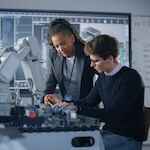Features

Among all employment sectors, engineering and technology are stereotypically replete with introverts, people who derive more pleasure, satisfaction, and energy from being alone as opposed to being in groups. While that is the stereotype, some engineers are extroverts, receiving much of their energy and enjoyment from being in the company of others. Fortunately for this group of people, many engineering occupations aren’t as introverted as they’ve been assumed to be.

The practical applications of environmental engineering have the potential to contribute to solutions to the plastic crisis, the climate crisis, the lack of sanitation on a global scale, the environmental impact of Western hunger for meat, and the devastating impact of fossil-fuel-based air travel.

This guide reveals how to ace a candidate interview for engineering school at the undergraduate and graduate levels. It includes a resource guide for preparation and how to draft stellar responses to common questions.

Bachelor’s and master’s level mechanical engineering students who secure internships will earn exceptional early work experience, learn which areas of mechanical engineering they like and dislike, and find themselves more likely to be hired by their target companies post-graduation.

The personal statement for engineering school is not just an essay. It has to be smart, engaging, typo-free, and capable of convincing exhausted admissions reviewers that you are a better fit for their program than the other thousands of applicants they are reviewing.

The concepts of civil engineering are particularly well-suited for the game environment, emphasizing the proper distribution of resources, the management of supply chains, and how the built environment interacts with the lived environment.

Many companies are turning towards cutting-edge technology known as “carbon capture” or “carbon removal” to tackle this issue. Carbon capture stores or utilizes carbon emissions from industrial processes before entering the atmosphere, whereas carbon removal removes excess carbon from the environment.

For engineering students who are passionate about creating a sustainable future, there has never been a better time to combine their skills with their commitment to the environment. Addressing the challenges of climate change requires innovative solutions, and cutting-edge engineering fields are at the forefront of these efforts. From developing renewable energy systems to designing sustainable infrastructure, these specialized disciplines provide the tools and opportunities to tackle environmental issues head-on while shaping a greener, more resilient planet.

The current US student loan debt is an astounding $1.75 trillion, with one in four Americans owing money. Unsurprisingly, student loan debt is the second-largest source of debt after mortgages.

By participating in a high school engineering program, students can build a solid foundation in STEM, form professional networks, and gain a clearer sense of their academic and career paths.
